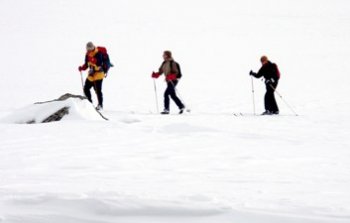Wearing several light articles of clothing-for instance, polypropylene or similar underwear and synthetic fleece overpants plus windpants, with a wool or fleece zip sweater and a wind-resistant jacket-allows you to trap warm air in pockets of space. In most conditions, wear just one or two insulating layers, depending on the weather and the kind of skiing you’ll be doing. Remove jacket and windpants when you’re hot; unzip jacket and sweater if you’re only warm. As the day heats up or the breeze dies, wind pants and windshell are removed; as chill sets in, on they go again. And these garments don’t restrict movement the way jeans or alpine ski bibs do. Many synthetic fabrics have the ability to "wick" moisture away from the skin and onto the next layer. In turn, the middle insulating layer should be quick-drying or wicking as well, so moisture ends up as close to the outside as possible. Moisture and cold air aren’t a happy mixture. If underclothes are wet and your skin is clammy, there’s an increased chance of hypothermia (a lowering of the body’s core temperature, often mistakenly called "exposure"). Cotton acts like a moisture sponge and accelerates chilling, so denim isn’t recommended. Gentlemen, those cotton shorts and briefs are best avoided on a cold day.
.jpg) Aside from buying warm, comfortable, "breathable" boots, the best thing for your feet is layering, too. Try wearing thin polypropylene liners under a pair of wool or wool-blend socks. If your toes are susceptible to cold, resist the temptation to put on too many socks-you’ll only restrict circulation, making feet colder. Instead invest in a pair of light overboots, and occasionally swig something warm, sweet, and non-alcoholic to help cut the chill. Mittens are best if you’re prone to cold hands, as they allow fingers to share body heat. Gloves are better for precise ski pole control.
Aside from buying warm, comfortable, "breathable" boots, the best thing for your feet is layering, too. Try wearing thin polypropylene liners under a pair of wool or wool-blend socks. If your toes are susceptible to cold, resist the temptation to put on too many socks-you’ll only restrict circulation, making feet colder. Instead invest in a pair of light overboots, and occasionally swig something warm, sweet, and non-alcoholic to help cut the chill. Mittens are best if you’re prone to cold hands, as they allow fingers to share body heat. Gloves are better for precise ski pole control.
For chilly weather, look for gloves with leather palms, a long gauntlet at the wrist and a light lining; in warmer conditions, critters a lot like handball gloves can be fine. Don’t use too heavy a pair or they’ll be sweat-soaked in the first kilometer. A final point: beware the sun. It’s amazingly easy to burn your skin, particularly on a hazy day, so wear sunscreen-you’ll still get a tan. Sunglasses are vital – snowblindness makes your eyes feel as though they’ve been sandpapered and can damage corneas.
Cross Country Skiing is also allowed on the Blue Ridge Parkway road-bed, in gated areas…during times of good snowfall. Have a great time and ski safely!

